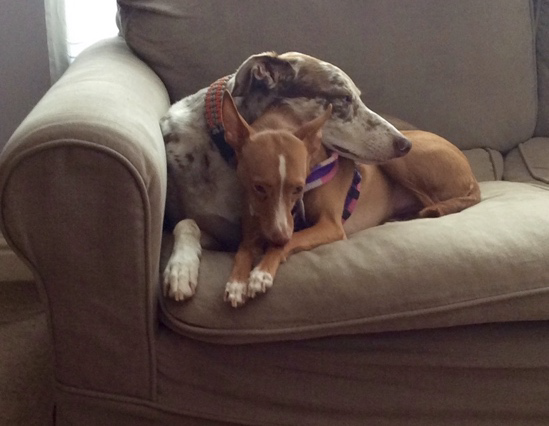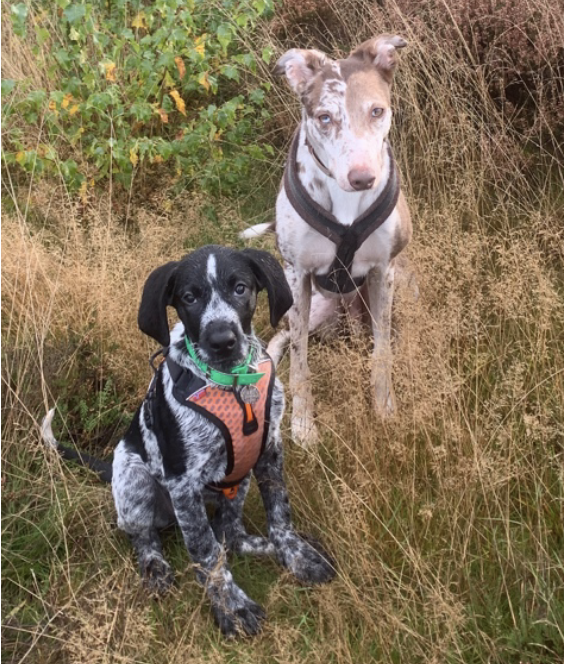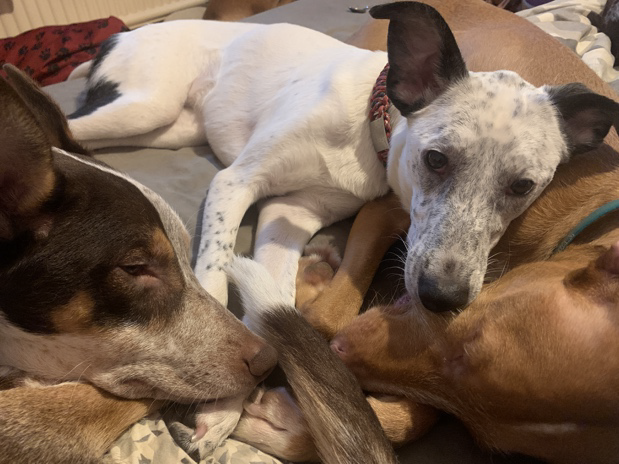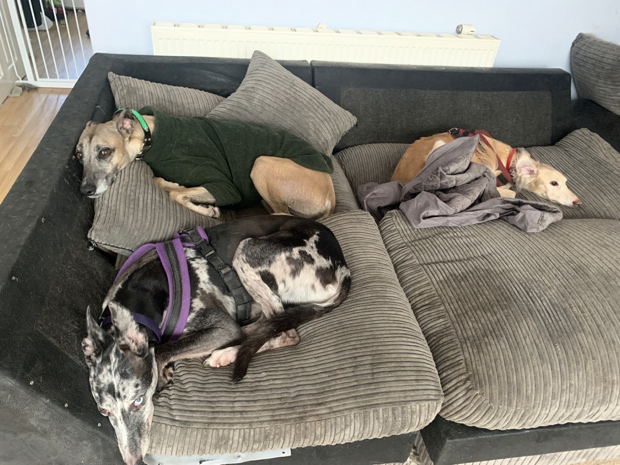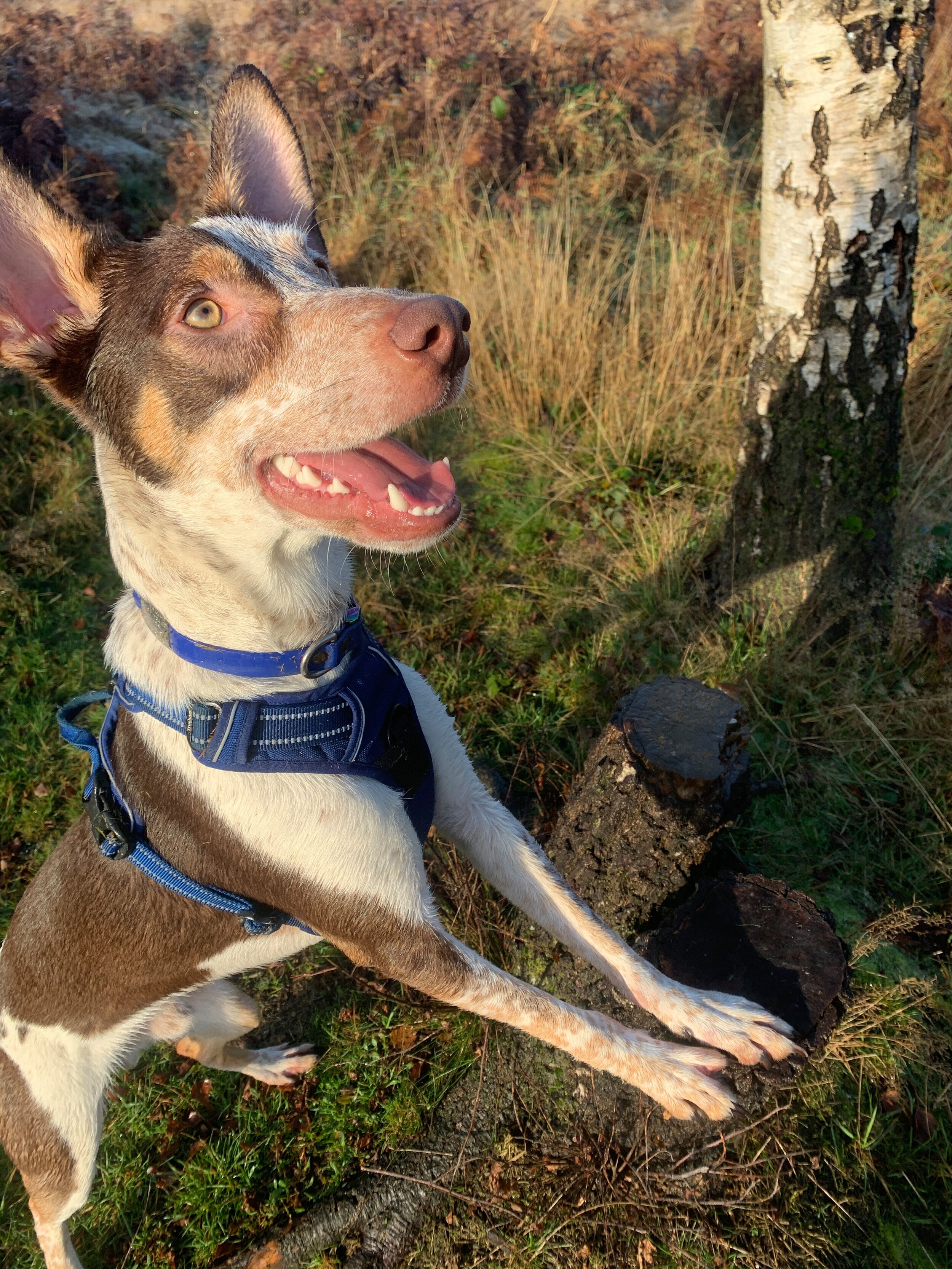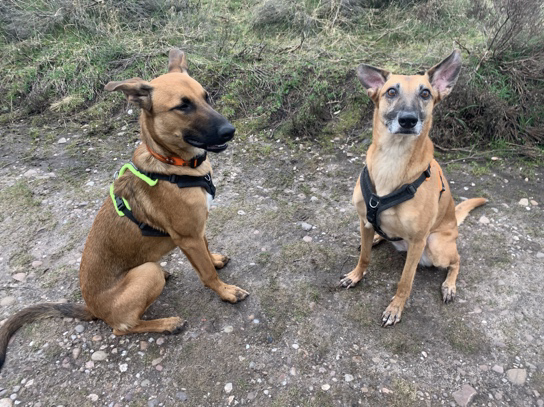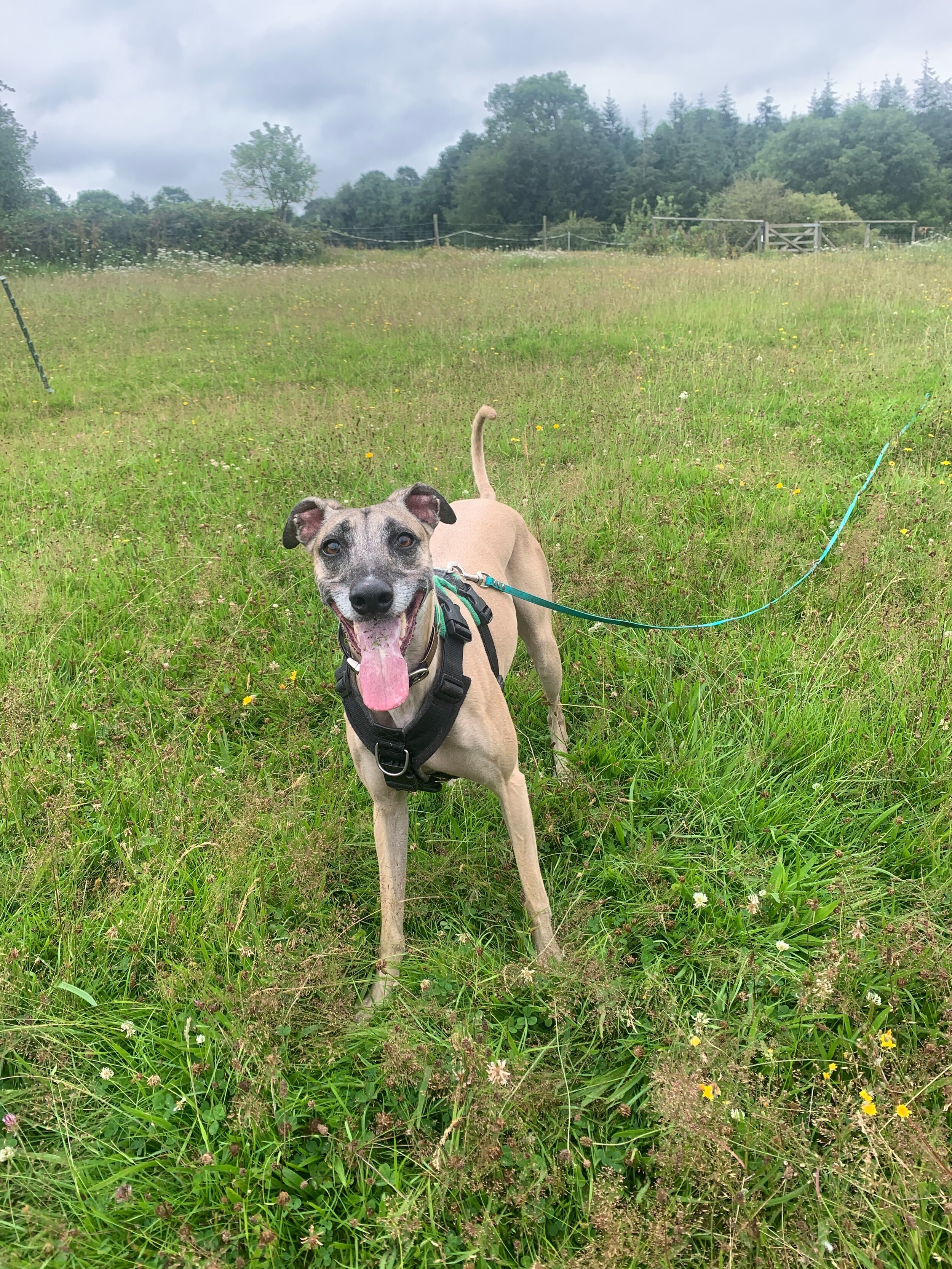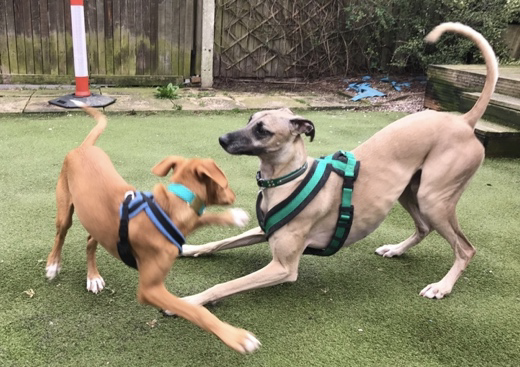Claire Martin on Introducing a new dog to the family
Are we all ready fo the next instalment from Claire Martin, our dog behaviourist and trainer extraordinaire? As many of you will know we are back transporting our rescued Podencos again, so we asked Claire to provide some support to our new pod families on Introducing a new dog to the family.
Adopting a dog from overseas has a few differences to one from your home country. When you adopt a Podenco you most likely won’t have met your dog in real life until they arrive in the transport van, often at a crazy hour of the morning! So the first thing you need to do is to prepare for their arrival.
Preparing for the arrival of a puppy or an adult dog is basically the same. They need somewhere safe to sleep, somewhere safe to eat and they need time to cope with the huge changes in their lives. I like my new dog to sleep in my bedroom where several of my other dogs also sleep, so I can hear them wake if they need to toilet (especially important with a puppy) and where they can learn that I am their new family. If you don’t want your dog to sleep upstairs with you then you would be best to plan to sleep downstairs with them for as long as they need to feel safe. To give my new dog somewhere where they wont be disturbed I use a crate initially, right beside my bed! The picture shows my room ready for a new Podenco puppy to arrive.
If you have multiple dogs then for their own happiness and comfort it’s important that they have their own space to eat. How would you feel if while you were eating dinner for the first time in your new family and the other residents were picking food off your plate – you might get defensive? Dogs are the same! Now I know that I am unusual in that I have 10 dogs but this is where most of my dogs eat! They are only shut in crates to finish their food and then the doors are wide open and they have access to this room as an extension of the lounge area.
All of my dogs are rescues and some have had resource guarding issues before they came to me so eating without the risk of disturbance is incredibly important to them. Helix, however came to me as a puppy with absolutely no resource guarding behaviour but he likes to savour his food – I have never known a dog that eats slower than him, he loves every morsel and he takes his time! Eating in a crate ensures that he isn’t disturbed and he can enjoy his meals at his own pace! However you decide to give your dog their own personal space to eat, be it in a crate or in separate rooms, never let one dog take the food of another or put pressure on a dog such that they feel vulnerable near their food.
However social and friendly your new dog was in their rescue, the process of moving into their new family is going to be a bit scary, they are arriving in an environment where everyone knows the routines and rules and they don’t. The most sociable child at school can feel quite out of their depth on arrival at college! Time, reassurance and personal space is important. We also need to consider the personalities in your home before the new dog arrives. Not all adult dogs love puppies (not all adult humans love babies!). When I bring a new dog into my home they don’t just walk into a group of 10 dogs! They first of all spend time with just me, learning to trust me first and the other dogs get to see them and smell them but from behind a baby gate.
I am lucky that I have some dogs that are super social and I know that they are used to new dogs arriving (we often foster and puppy-sit for friends) but I have dogs who might take 3-6 months to accept that the new family member is someone they want to interact with. Strike, my saluki is a “grumpy grandpa” – he doesn’t welcome new dogs into the house particularly willingly but one day, all of a sudden he will decide they are the best friend he has ever had! As a result he doesn’t mix freely with new dogs until he feels comfy – he is an old dog and he deserves his space. Young dogs are often terrible at reading an older dogs body language. Darwin, on the other hand, loves puppies, they keep him young! He loves them jumping on him and he lets them bite his tail! In fact I have to make sure that a new puppy doesn’t take advantage of his kindness! There are no hard and fast rules but the key is to know each of your dog’s personalities and give them the space and the time to learn to like each other and in time they will learn to love each other. Your dream might be that your dogs will snuggle together and sleep in an ungainly pile of limbs and bodies but that might not be their dream.
These two photos are of my dogs being relaxed and social. One group are literally glued together but the other group aren’t touching each other – this is their preference. Some of my new dogs have literally been integrated within the family in 1 day, others have taken months – each is very much an individual.
So – you have set up everything ready for your new arrival, they have their own space in your home apart from other dogs and they have arrived, eaten and you want to introduce them to the rest of the family. This is best done outside on a walk, away from the home. That might mean hiring a secure field or it might just be a side-by-side walk in the park. It really depends on the nature of the two dogs that are meeting. Some dogs just gel as if they have always been destined to live together, some take longer. There is no hard and fast rule but sharing activities where they are both able to enjoy time spent together will help them become friends. If you have two dogs, don’t slip into the habit of only ever walking your new dog with the dog that was there first – its all too easy for a dog to become dependent on the other and that results in an unhealthy dependency which is detrimental to their friendship. Mix things up, sometimes walk the dogs individually and sometimes together. In these pictures Helix is enjoying his individual walk whereas Base is having his first walk with a reliable older dog to give him some early confidence.
Some of my dogs have come to me as rescue puppies, born into safety and raised with love and care by the rescue. Others have come with baggage from their past, rescued as adults from various situations. So – how do we work with these dogs that have “issues”. Your rescue will have done their best to give you all the information they have about the dog you are adopting and will have tried to match the right personality dog to your home but for many dogs there will be multiple unknowns. First of all you need to be realistic in your expectations of your new dog. If the rescue doesn’t know much about their life before rescue then try not to make up a narrative that feeds into any insecurities your dog might display. For example my latest rescue came to me as a 7 month old adolescent. He is nervous around men, this isn’t because men have abused him, it’s more likely as a result of him being in an all human female environment. He has very quickly got used to men because I didn’t have a narrative that precluded that possibility. Try to avoid making judgements on your dogs’ behaviour that are justified in your mind by their past experiences. Most dogs haven’t been abused and even if they have, holding on to that narrative doesn’t help them to recover. Give them time, train them positively, play games and be kind and most dogs will move beyond their past experiences.
If your dog arrives at your home and is terrified, just leave them alone, ignore them, let them just find somewhere they feel safe and let them make the first move. If you have children then they need to ignore your dog too and that includes avoiding eye contact as much as possible. Make sure that a scared dog, (in fact any dog) is wearing a secure collar with your details on it and ideally a harness attached to a long line if possible before they go out, even into your garden. Some dogs might not eat until night time. Let then dictate the pace that they feel able to interact with you. Thankfully few Podencos are re-homed in such a terrified state but some come into rescue as very fearful dogs and they can regress to that state when they move to their forever home.
About 2-3 weeks after a new dog arrives in their new home its really common for their temperament to change, except it hasn’t – it’s just that the first two weeks they have been “keeping their head down” until they felt safe! What you are seeing now is who they really are! That might be a cheeky, more confident dog but this is a good change and you are now seeing the real dog and can start to work on any behaviours that might not be to your liking. It can take months though for the whole personality of your new dog to show itself – so be prepared and be optimistic and ask for advice if you need help.
House rules in different homes can vary. I like my dogs to sleep where they want and some choose to sleep up with me in my bed, some prefer the sofas but it’s also absolutely fine for dogs to sleep in their own beds and not to be allowed on furniture. If you have house rules then don’t let your dog get them wrong in the early days – so if you don’t want your dog to sit on the sofa then turn the sofa round and barricade it off and sit on the floor with your dog until they are happy that this is where they can settle (oddly when I give this advice I usually find that a week later the dog is welcomed onto the sofa!). Use stair gates to prevent a dog having access to rooms that you don’t want them to enter and if you don’t want your dogs to do the pre-wash of your crockery or take human food then eat at a table and don’t feed them from your plate.
Adopting a rescue dog can be the most wonderfully rewarding experience ever and adopting another is usually every bit as much fun but sometimes, remarkably rarely, when a dog travels to their new home they just aren’t compatible with the dogs already in the home. If this happens to you it can be devastating but no one wants a dog to be unhappy. If you are advised that your new dog isn’t compatible with your existing family members then it is the right decision to let the new dog find a more suitable home, however hard this is, try not to blame yourself. Dogs, like people, don’t like every other member of their species.
Claire Martin at Chrysalis K9 is a CAPBT behaviourist and trainer and currently shares her life with 10 rescue sighthounds including 5 Podencos/Podenco crosses.



